Effective Non-Drug Therapies for Knee Osteoarthritis
A meta-analysis published on June 18, 2025, in the open-access journal PLOS One, conducted by Yuan Luo of the First People’s Hospital of Neijiang, China, highlights knee braces, water therapy, and exercise as the most promising non-pharmacological treatments for knee osteoarthritis (KOA).
Understanding Knee Osteoarthritis
Knee osteoarthritis is a prevalent and often debilitating condition that impacts millions of older adults by causing pain and stiffness in the knee joint. Traditional treatment options typically include anti-inflammatory medications, which are associated with potential gastrointestinal and cardiovascular complications.
Research Overview
The study assessed current evidence regarding non-drug therapies for KOA by analyzing data from 139 clinical trials encompassing nearly 10,000 participants. The research compared twelve different non-drug treatments, including laser therapy, electrical stimulation, knee braces, insoles, kinesiology tape, water therapy, exercise, and ultrasound. By employing a comprehensive network meta-analysis, the researchers could rank these therapies based on their efficacy.
Key Findings
Knee braces were found to be the most effective intervention across various categories, including pain reduction, functionality improvement, and alleviation of stiffness. Hydrotherapy, which encompasses exercises or treatments conducted in warm water, emerged as particularly effective in relieving pain. General exercise also demonstrated consistent benefits, enhancing both pain management and physical function. In contrast, high-intensity laser therapy and shock wave therapy revealed some positive effects, whereas ultrasound scored the lowest on effectiveness.
Considerations and Future Directions
The study authors acknowledged that variations in study design, small sample sizes, and differences in treatment duration could limit the precision of the efficacy rankings. Nonetheless, they concluded that physical therapy provides promising outcomes for KOA, offering viable treatment alternatives that circumvent the risks associated with anti-inflammatory drugs. Future investigations should focus on assessing the clinical efficacy and cost-effectiveness of combined therapies.
Conclusions
The authors emphasized the significance of knee braces, hydrotherapy, and exercise as the most effective non-drug therapies for knee osteoarthritis, highlighting their ability to reduce pain and enhance mobility without the gastrointestinal or cardiovascular risks linked to common pain medications. They encourage both patients and clinicians to prioritize these evidence-based interventions.
“Our comprehensive analysis involving nearly 10,000 patients indicates that simple, accessible therapies like knee bracing and water-based exercises outshine advanced technological options such as ultrasound. This insight has the potential to reshape clinical guidelines, steering attention toward safer and lower-cost interventions.”
Key Health Takeaway
Emphasizing simple yet effective non-drug therapies, this study reinforces the importance of knee braces, hydrotherapy, and exercise in managing knee osteoarthritis, offering safe alternatives to traditional pain medications.





